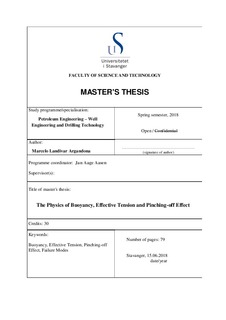| dc.contributor.advisor | Aasen, Jan Aage | |
| dc.contributor.author | Landivar Argandona, Marcelo Gerardo | |
| dc.date.accessioned | 2018-10-30T15:05:47Z | |
| dc.date.available | 2018-10-30T15:05:47Z | |
| dc.date.issued | 2018-06-13 | |
| dc.identifier.uri | http://hdl.handle.net/11250/2570243 | |
| dc.description | Master's thesis in Petroleum engineering | nb_NO |
| dc.description.abstract | The thesis addresses at the beginning the understanding of the development of forces that result in buoyancy, and the concept of effective forces. Then, it continues more in-depth with an application of effective forces to an experiment named the pinching-off effect, and the following explanation on the unsolved fracture of the rod in the experiment.
Having two different approaches that interpret the origin of buoyant forces, the thesis describes the limitation of the Archimedes' principle when the body under analysis is not in contact with fluids in the whole surfaces. It remarks the absence of an upward force in cases when even if there is fluid displacement, no vertical pressure difference will create the upthrust. Then, the first section of the thesis illustrates the misunderstandings of buoyancy through experiments performed that support the conception of buoyancy following the piston force approach.
In addition, the petroleum industry manages several applications of the principle. Thus, the comprehension of the difference between real forces and effective forces in design and analysis performed for wellbore involves the awareness of how the forces behave in the wellbore regarding fluids and tubular. The thesis dedicates a section to the effective tension and its incidence in cases of sub-sea operations or well engineering where it is shown that there is zero buoyancy although the analyzed tubular is submerged in the well. This happens when the cross-sectional area of steel at the outside bottom of a pipe is isolated. Further, the present document reinforces the concept of the analogy of the total stress state and the deviatoric stress to real and effective forces, respectively.
The "Pinching-off effect experiment" was an experiment conducted by Bridgman around a century ago applying high pressure to different tubular materials in a pressure vessel and studying the results. The experiment was labeled as a paradox and had provoked a series of disagreements in the scientific setting regarding the reasons for the fracture of the rod. | nb_NO |
| dc.language.iso | eng | nb_NO |
| dc.publisher | University of Stavanger, Norway | nb_NO |
| dc.relation.ispartofseries | Masteroppgave/UIS-TN-IEP/2018; | |
| dc.rights | Navngivelse 4.0 Internasjonal | * |
| dc.rights.uri | http://creativecommons.org/licenses/by/4.0/deed.no | * |
| dc.subject | petroleumsteknologi | nb_NO |
| dc.subject | petroleum technology | nb_NO |
| dc.subject | boreteknologi | nb_NO |
| dc.subject | brønnteknologi | nb_NO |
| dc.title | The Physics of Buoyancy, Effective Tension and Pinching-off Effect | nb_NO |
| dc.type | Master thesis | nb_NO |
| dc.subject.nsi | VDP::Teknologi: 500::Berg‑ og petroleumsfag: 510::Petroleumsteknologi: 512 | nb_NO |

